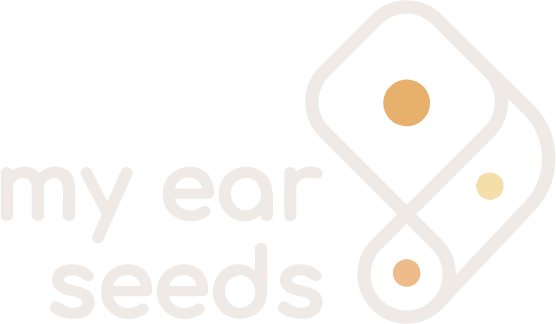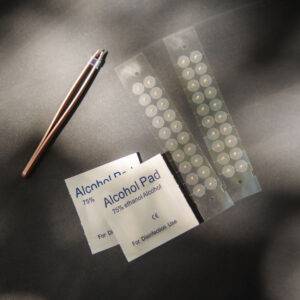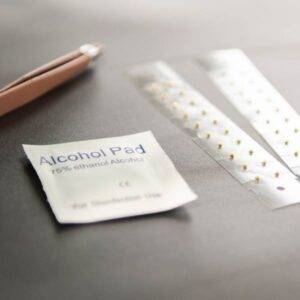Sleep apnea, the sleep disorder often marked by snoring, hits close to home for us. Kaci, our My Ear Seeds Owner and Founder, has sleep apnea, and so does her father. Her father has had surgeries to try to overcome this condition; now, he continues to use a CPAP machine for sleeping.
Neither Kaci nor her father have tried ear seeds as a natural remedy for sleep apnea…yet! This article is about to shake things up for both of them, though.
What is sleep apnea?
Sleep apnea is a common sleep disorder that can affect the way you breathe while you’re asleep. Imagine your throat as a narrow hallway, and when you fall asleep, the muscles in the back of your throat relax too much, causing that hallway to become blocked or narrow. This blockage can temporarily stop your breathing or make it very shallow.
When this happens, your brain senses that you’re not getting enough oxygen, and it wakes you up briefly to reopen the throat and allow you to breathe again. These awakenings are usually so quick that you might not remember them, but they can happen many times throughout the night, disrupting your sleep.
Sleep apnea is one of those conditions that need to be addressed sooner rather than later. It not only irritates and disturbs others, it’s also dangerous for the person who has it. Hazards of untreated sleep apnea include:
- Daytime fatigue and sleepiness, leading to an increased risk of accidents, poor judgment, and memory and cognitive impairment
- Cardiovascular issues
- Type 2 diabetes
- Weight gain
- Mood disorders
- Frequent nighttime urination (called nocturia)
- Impaired immune function
- Worsening of pre-existing medical conditions
We already know ear seeds can help with sleep issues like insomnia, but what does the research say about this type of acupressure therapy as a natural remedy for sleep apnea? We think you’ll be intrigued enough by the studies that you’ll want to try the ear seeds for yourself. Read on!
Important note: The severity and impact of sleep apnea can vary widely from person to person. If you suspect you have sleep apnea or have been diagnosed with it, you should seek medical evaluation and appropriate treatment. Untreated sleep apnea can have serious health consequences. The information included in this article is for educational and informational purposes only and should not be taken as medical advice.

Research on ear seeds as a natural remedy for sleep apnea
You’ll notice that the two study methodologies’ below are almost identical; this is because they share the same primary author. But look closely and you’ll see a couple of distinct differences too.
Study 1 design and results
- 45 participants (44 were female, 1 was male)
- All had obstructive sleep apnea syndrome
- Two groups: treatment (n=30) with auricular acupoint pressing therapy on 8 designated points (see “Ear acupressure points for sleep apnea” section below); and control (n=15) with a placebo treatment of Vitamin C three times daily
- 10 days of pressing on the points (3-5 times per day, 10-20 presses each of those times)
- Polysomnography during a 7-hour sleep period was done before the study and 10 days after the study began
Disclaimer: The version of the study we read didn’t specifically mention ear seeds, but acupoint pressing therapy is very similar.
Treatment group results:
- Significant decrease in number of times waking up (from 4-5 times to 0-1 times)
- Improvements compared to the control group were found across these measures: hypopnea index, apnea index, apnea hypopnea index, minimum blood oxygen saturation, and longest apnea time
Study 2 design and results
- 45 participants (44 were male, 1 was female)
- All had obstructive sleep apnea syndrome
- Two groups: treatment (n=30) with ear seeds on 8 designated points; and control (n=15) with a placebo treatment of Vitamin C three times daily
- 10 days of pressing on the points (3-5 times per day, 10-20 presses each of those times)
- Polysomnography during a 7-hour sleep period was done before the study and during the 10 days of the treatment course
Treatment group results:
- Reduction of clinical symptoms of sleep apnea including snoring, dizziness, chest heaviness, and pharyngeal obstruction
- Decrease in number of times waking up to pee (from 4-5 times to 0-1 times)
- Decrease in number of times waking up due to apnea (from 4-5 times to 0-1 times, for an improvement rate of at least 95%!)
- Significant reduction in hypopnea index, apnea index, and apnea hypopnea index
- Significant increase in oxygen saturation
- Reduction in longest apnea time
- Reduction in waking time and waking frequency
The control group didn’t show significant improvements across any measures.
The researchers specifically pointed out that other advantages of ear seeds as a natural remedy for sleep apnea, beyond the obvious ones, are their inexpensiveness and lack of side effects.
Ear acupressure points for sleep apnea
Acupressure points used in the 2006 study:
- Shen Men
- Sympathetic
- Subcortex
- Heart
- Lung
- Spleen
- Kidney
- Anterior Lobe
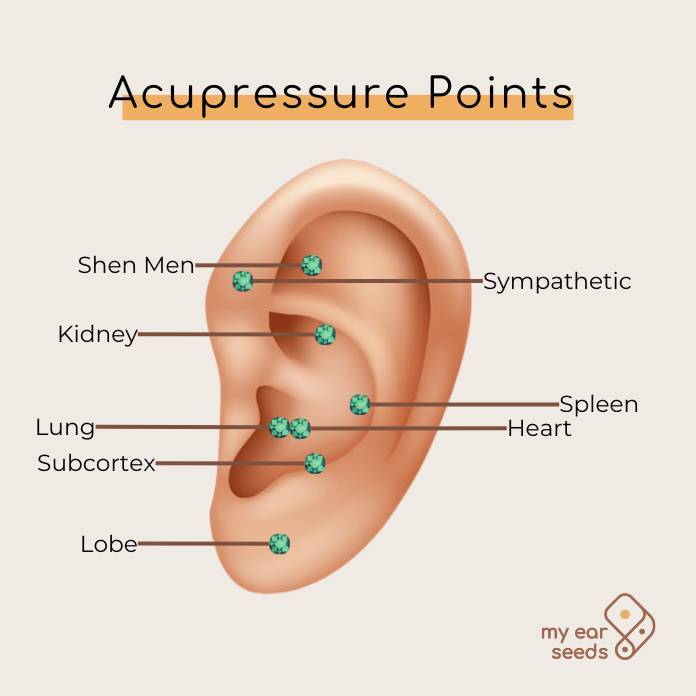
Conventional therapies for sleep apnea
Continuous Positive Airway Pressure (CPAP) machine
While exploring a natural remedy for sleep apnea, such as ear seeds, it’s essential to acknowledge conventional therapies that have proven effective in managing this sleep disorder.
One common treatment approach is the Continuous Positive Airway Pressure (CPAP) machine. This device, though not inherently holistic, can be integrated into a holistic wellness routine. CPAP therapy involves wearing a mask that delivers a steady stream of air pressure to keep your airways open during sleep.
It’s considered highly effective in preventing the airway blockages responsible for sleep apnea episodes, therefore improving oxygen flow and sleep quality. Although it may seem less of a natural remedy for sleep apnea compared to alternative remedies, holistic practitioners can work with patients to incorporate CPAP therapy in a balanced and mindful way.
Uvular pharyngoplasty
Uvular pharyngoplasty is another conventional treatment that some patients opt for when non-surgical methods don’t cut it. It’s a surgical procedure aimed at reducing or eliminating snoring and sleep apnea by reshaping the back of the throat.
During uvular pharyngoplasty, a surgeon makes small adjustments to the throat tissues, including the uvula, to make more space for air to flow smoothly. This might involve removing excess tissue or repositioning certain structures.
So whether it’s the CPAP machine or uvular pharyngoplasty, the goal with the ear seeds would be to aim for a comprehensive approach to sleep apnea management that combines the best of conventional and alternative strategies for optimal well-being.
Another natural remedy for sleep apnea
This section of the article includes an affiliate link. If you click and purchase, we may receive a small commission, at no extra cost to you.
Have you noticed the rise of myofunctional therapy as another natural remedy for sleep apnea? These functional practitioners are increasing in demand as more people start to understand how strong, well-functioning facial and tongue muscles are tied to better breathing, especially at rest or during sleep.
This field of research on sleep apnea is not our space, so we want to share an opportunity, created by someone else, to test-drive some powerful throat exercises. You can do these exercises in just a few minutes every day to see if they’ll help with your apnea.
Even if straps, sprays, CPAPs, and tapes have failed you in the past, you might find the results you’re seeking by strengthening the muscles around your airway. At the least, this program certainly can’t hurt! And like ear seeds, these exercises are relatively inexpensive, easily accessible, and usable by nearly everyone, regardless of age or physical shape. Plus, they’re easy to incorporate into your lifestyle (also like ear seeds); you can do them anywhere — we like to do them while stuck in traffic or watching TV.
Learn more about these throat exercises as a natural remedy for sleep apnea »
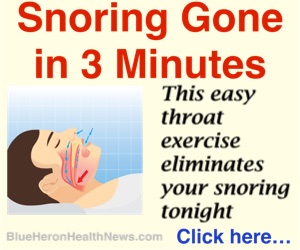
References:
Wang, X. H., Xiao, L. Y., Wang, B. F., Yuan, Y. D., Pan, W. S., & Shi, Y. Z. (2009). Influence of auricular plaster therapy on sleeping structure in OSAS patients. Journal of traditional Chinese medicine = Chung i tsa chih ying wen pan, 29(1), 3–5. https://doi.org/10.1016/s0254-6272(09)60020-0
Wang, X., Yuan, Y., Wang, B., Xiao, L., Pan, W., & Shi, Y. (2006). Auricular acupoint pressing therapy in the treatment of obstructive sleep apnea syndrome. Chinese Journal of Tissue Engineering Research, (53), 165-167.
